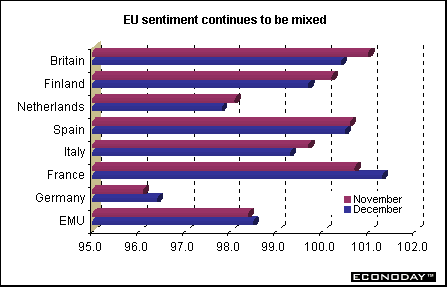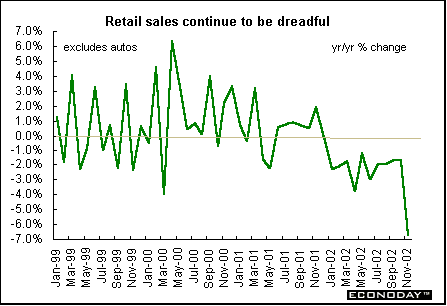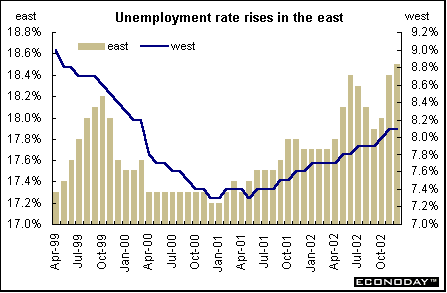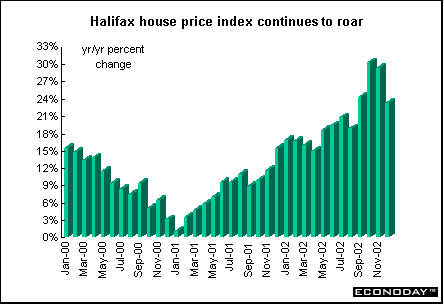
Indicator scoreboard
EMU - December Reuters services purchasing managers survey slipped to 50.6 from 50.8 in November. An index reading above 50 indicates that activity is expanding, while a reading below 50 that it is contracting. Germany remained the weak spot, as sector activity there contracted at an even faster pace for the fifth straight month. In France, by contrast, activity expanded for the 13th straight month. The composite index, which combines the industry and services indexes, declined to 50.5 in December from 51.1 in November. New orders are more or less stagnant and employment is still on a downtrend.

November seasonally adjusted unemployment rate remained unchanged at 8.4 percent. Of the nine EMU states reporting data for November, unemployment rose in five, fell in one and remained unchanged in three. Spain continued to show the highest unemployment rate and Luxembourg the lowest. It is estimated that 11.7 million men and women were unemployed throughout the EMU.

November industrial producer prices (excluding construction) fell 0.3 percent but were up 1.1 percent when compared with last year. Most of the decline in the monthly reading was due to lower energy prices. Excluding energy (and construction), the industrial PPI was flat but climbed 1.0 percent on the year.
October real seasonally and workday adjusted retail sales rose 0.7 percent on the month and 1.6 percent on the year. All retail trade categories rose with the exception of books, newspapers sales and household goods.

Third quarter real gross domestic product was unrevised at 0.3 percent on the quarter and 0.8 percent when compared with last year. A downward revision in inventories was offset by upward revisions for gross fixed capital formation and net exports.

EU - December EU Commission's economic sentiment index crept up to 98.5 from 98.4 in November. The increase was due to improving business and construction confidence, which outweighed drops in consumer and retail confidence. Services sector sentiment, which is not part of the overall index, also declined slightly. Industrial confidence rose to minus 9 from minus 11 in November. Among subcategories, production expectations, sentiment on current order book levels and export order books rose but stocks of finished goods fell. Consumer confidence fell to minus 16 from minus 14 in November. Industrial confidence accounts for 40 percent of the index, with consumer confidence, retail trade and construction confidence each accounting for 20 percent.

Germany - November real seasonally adjusted retail sales excluding auto and petrol station sales fell 3.7 percent and 6.0 percent on the year. Total real retail sales including auto and petrol station sales fell 3.9 percent and 5.7 percent when compared with last year.

December seasonally adjusted unemployment rose by 28,000 to 4.197 million. Unemployment jumped by 20,000 in west Germany while in east Germany unemployment climbed by 8,000. Seasonally adjusted employment rate rose to 10.1 percent from 10.0 percent the previous month. East German unemployment rate rose to 18.5 percent from 18.4 percent in November while in the west, the unemployment rate remained at 8.1 percent.

November seasonally adjusted merchandise trade surplus was €11.1 billion, up from a €9.9 billion surplus in October and up from a €6.2 billion surplus in November 2001. Exports were up 3.1 percent and 10.0 percent on the year. Imports were up 1.4 percent and 0.7 percent on the year.
November seasonally adjusted manufacturing orders rose 1.7 percent following an unrevised increase of 1.1 percent in October. Orders rose 5.9 percent on the year. The surge in orders was attributed to big-ticket items from abroad. (Any order worth more than €500,000 euros qualifies as big-ticket item.) Foreign demand rose 4.3 percent but domestic demand was down 0.4 percent. Investment goods orders rose 2.0 percent. Domestic demand for investment goods fell 0.4 percent while foreign demand rose 4.2 percent. West German manufacturing orders rose 1.7 percent while in east Germany, orders rose 1.5 percent.

France - Final third quarter seasonally and workday adjusted gross domestic product rose 0.2 percent after rising 0.4 percent in the second quarter. GDP rose 0.8 percent when compared with the third quarter of 2001. Falling investment and inventory cuts undermined buoyant private consumption. Business fixed investment dropped 0.8 percent, household investment dipped 0.1 percent, while public investment plunged 1.1 percent.

Britain - December Chartered Institute of Purchasing and Supply services survey fell to 53.2 from 54.9 in November, but is still well above the 50-contraction/expansion level. Both new and outstanding business fell.
December Halifax house price index rose 1 percent and 23.3 percent when compared with last year. House price growth in 2002 was one of the highest on record, thanks to a combination of low interest rates, low unemployment, and a persistent shortage of properties available for sale.

November global goods merchandise trade deficit widened to a new record, driven higher by a significant decline in oil exports. The global trade in goods deficit widened to a record Stg3.982 billion from Stg3.626 billion previously. The value of exports fell 5.3 percent while imports declined 2.4 percent. The non-EU deficit ballooned to Stg3.072 billion from Stg2.383 billion in October. Much of the latest deterioration in the global trade gap was due to lower exports of crude oil, especially to the U.S. The value of oil exports plunged 19.7 percent in November while imports rose 7.9 percent, causing the usual oil surplus to shrink to Stg163 million from Stg455 million. Excluding the volatile oil and other erratic items, the global goods deficit still widened, but by less, to Stg3.753 billion from Stg3.657 billion.
Americas
Canada - December unemployment rate remained at 7.5 percent. Employment rose by an estimated 58,000, mostly in full-time work, giving 2002 its highest annual growth rate (560,000 or +3.7 percent) since 1987. The proportion of working-age population holding a job (the employment rate) rose to a record high of 62.4 percent. The labor force participation rate in December was 67.5 percent, equaled only once before, in January 1990. Full-time employment rose by 46,000 and part-time employment rose 220,000. Manufacturing employment fell by 25,000 jobs, almost entirely due to automobile layoffs in Ontario. However, manufacturing provided an increase of 125,000 jobs (up 5.6 percent) for the year.



Last Week's Highlights • Global
Stock Market Indexes • Recap of Global Markets
• Currencies • Indicator
Scoreboard

The Bottom Line •
Looking Ahead
|